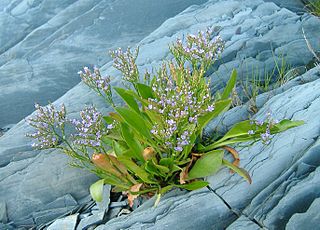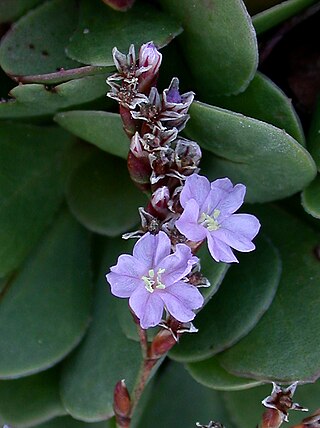
Limonium is a genus of about 600 flowering plant species. Members are also known as sea-lavender, statice, caspia or marsh-rosemary. Despite their common names, species are not related to the lavenders or to rosemary. They are instead in Plumbaginaceae, the plumbago or leadwort family. The generic name is from the Latin līmōnion, used by Pliny for a wild plant and is ultimately derived from the Ancient Greek leimon.

Limonium arboreum is a species of sea lavender known by the common name tree limonium and siempreviva. It is endemic to the Canary Islands, where it is a plant of coastal habitat.
Limonium jovibarba is a species of flowering plants of the family Plumbaginaceae. The species is endemic to Cape Verde. It is listed as critically endangered by the IUCN. The species was named by Carl Ernst Otto Kunze in 1891. Its local name is carqueja, a name that may also refer to the related species Limonium brunneri and Limonium braunii.
Limonium brunneri is a species of flowering plants of the family Plumbaginaceae. The species is endemic to Cape Verde. It is listed as critically endangered by the IUCN. The species was named by Carl Ernst Otto Kunze in 1891. Its local name is carqueja, a name that may also refer to the related species Limonium braunii and Limonium jovibarba.
Statice limonium may refer to:

Limonium vulgare, called common sea-lavender, is a species of flowering plant in the genus Limonium native to Atlantic parts of Europe from southwestern Sweden to southwestern Iberia, and introduced elsewhere. A clumping perennial found in salt marshes and other maritime habitats, it is a probable species complex that includes Limonium maritimum and L. narbonense.

Limonium carolinianum, known variously as Carolina sealavender, canker root, ink root, marsh root, lavender thrift, American thrift, or seaside thrift, is a species of flowering plant native to the eastern shores of North America, from northern Mexico to Canada. It is a slow-growing perennial herb found in salt marshes and other maritime habitats. Its inflorescences are frequently harvested for use in cut flower arrangements.

Geranium tuberosum, the tuberous-rooted cranesbill, is a species of flowering plant in the family Geraniaceae. It is native to the Mediterranean region, the Caucasus, and western Asia. The Royal Horticultural Society considers it a good plant to attract pollinators, and it is widely available from commercial suppliers. There are a number of cultivars available, including 'Rosie's Mauve' and 'Richard Hobbs'.

Limonium platyphyllum, the broad-leaved statice, or florist's sea lavender, is a species of flowering plant in the family Plumbaginaceae. It is native to the Black Sea region; Bulgaria, Romania, Ukraine, Crimea, south and east European Russia, and the Caucasus, and it has been introduced to Great Britain. A perennial halophyte 60 to 75 cm tall, it is widely available from commercial suppliers. There are a number of cultivars, including the well-known 'Violetta' which has darker petals.

Limonium minutum, the dwarf statice, is a species of flowering plant in the family Plumbaginaceae, native to the Balearic Islands. A halophyte found in coastal habitats, it is occasionally available from commercial suppliers.

Limonium gmelini, the Siberian statice, is a species of flowering plant in the family Plumbaginaceae, native to east-central and southeastern Europe, Russia, the north Caucasus, Turkey, Iran, Kazakhstan, Kyrgyzstan, parts of Siberia, Xinjiang, and Mongolia. A widespread halophytic species, it is found growing in seeps, meadows, steppes, roadsides, and wastelands, as long as they are saline.

Limonium puberulum, the downy sea lavender, is a species of flowering plant in the family Plumbaginaceae, native to subtropical elevations of Lanzarote in the Canary Islands. It is morphologically similar to but genetically distinct from Limonium bourgeaui.

Limonium bourgeaui is a species of flowering plant in the family Plumbaginaceae, native to Lanzarote and Fuerteventura in the Canary Islands. A herbaceous perennial and subshrub, it is morphologically similar to but genetically distinct from Limonium puberulum.
Limonium sinense is a species of flowering plant in the sea lavender genus Limonium, family Plumbaginaceae, native to coastal China, Taiwan, the Ryukyu Islands, and Vietnam. It is a perennial reaching 60 cm (24 in), found on sandy, salty shales next to the ocean. There are a large number of cultivars, with a wide variety of flower colors, created for the cut flower industry. Wild individuals have flowers with white sepals and yellow petals.

Limonium tetragonum, the square-stalked sea lavender, is a species of flowering plant in the family Plumbaginaceae. It is native to Primorsky Krai in Russia, South Korea, central and southern Japan, the northern Ryukyu Islands, and New Caledonia some 6,800 km (4,200 mi) away. A biennial halophyte, it can be found growing at the high tide line in coastal wetlands and in salt marshes. It is collected in the wild and eaten as a vegetable, and is considered to have medicinal properties. There appears to be an ornamental cultivar, 'Confetti'.
Limonium otolepis, the saltmarsh sea lavender, lacy sea lavender or Asian sea lavender, is a species of flowering plant in the family Plumbaginaceae. It is native to Afghanistan, Central Asia, and Xinjiang and western Gansu in China. A halophyte, it is common in saline areas, such as the bed of the former Aral Sea. It has been introduced to California as a garden escapee, and is also present in southeastern Australia. There appears to be an ornamental cultivar, 'Lavender Lace'.

Limonium bonduellei, the yellow statice, is a species of flowering plant in the family Plumbaginaceae. The Global Biodiversity Information Facility calls it Algerian statice and lists it as Limonium sinuatum subsp. bonduellei, but a 2018 molecular study showed that it is good species with 100% bootstrap support. An annual facultative halophyte reaching 50 cm (20 in), it is native to Spain and North Africa, and has been introduced to Italy. It is naturalized in New Zealand.

Limonium hyblaeum, the Sicilian sea lavender or Rottingdean sea-lavender, is a species of flowering plant in the family Plumbaginaceae, native to Sicily. A cushion-forming perennial, it is an incipient invasive in Australian coastal areas.

Limonium dendroides is a species of flowering plant in the family Plumbaginaceae, native to La Gomera in the Canary Islands. There are fewer than 40 mature individuals remaining in the wild, with the number decreasing.

Limonium lobatum, the winged sea-lavender, is a species of flowering plant in the family Plumbaginaceae, native to the Canary Islands, Spain, Greece, North Africa, and the Middle East as far as Iran. It is an incipient invasive in Australia.














